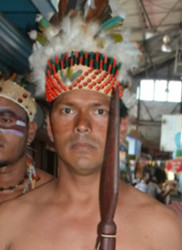Concerns over the omission of St Cuthbert’s Mission in the supplying of troolie palm leaves for the rebuilding of the Umana Yana in Kingston have been resolved, according to village Toshao Lennox Shuman, who has promised to provide leaves of exceptional quality for the project.
“We met with Minister [Valerie Garrido]-Lowe and have come to a temporary solution. You know we all want peace,” Shuman said when contacted by Stabroek News yesterday.
A resident had complained to Stabroek News that the Amerindian village hadbeen shorted in the procurement process for the troolie palm leaves, which is to be used for the Umana Yana’s roof.

It was explained that the palm leaves for the roof of the benab, which was destroyed by fire in September 2014, would come from Masakenari, Moraikobai and St Cuthbert’s Mission. However, the resident lamented that while the building and thatching had commenced, the St Cuthbert’s Mission had not been contracted to supply the leaves.
Minister in the Ministry of Indigenous Peoples’ Affairs Garrido-Lowe told this newspaper when contacted on Sunday that she was aware of the issue but noted that “there is more to it.” She had indicated that a meeting was scheduled for Monday to reach a resolution.
Shuman yesterday would only say that a resolution was had and that he and his village were committed to seeing the Umana Yana completed. He promised to supply leaves of exceptional quality while saying they would be a reflection of his village.
The village toshao said that he understands the concerns of his villagers about being shortchanged of needed revenue but added that peace was what mattered. “We want peace and while they might be right that we lose on some money, in the end it’s the benab that matters and having that peaceful meeting place built by the Amerindians…the resolution is temporary so we wait and see,” he said.
Construction of the $66.7 million structure commenced last month, with more than 32 Wai Wai men from Region Nine (Upper Takutu-Upper Essequibo) working to complete the “shell” of the benab in an eight-week timeframe. It is planned for the monument to be fully functional by Independence Day.
The monument was originally erected by more than 60 Wai Wais in 1972 to facilitate the Non-Aligned Movement meeting here.





